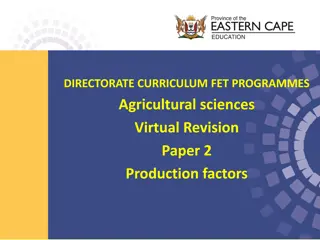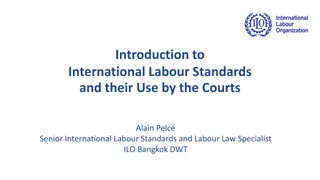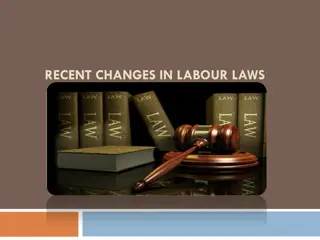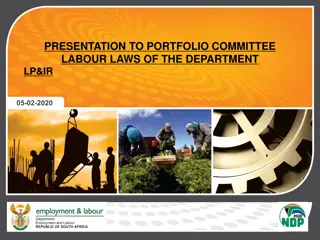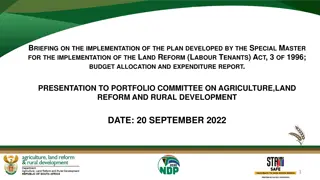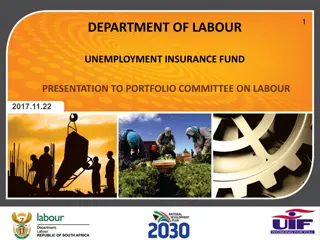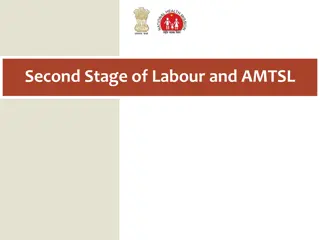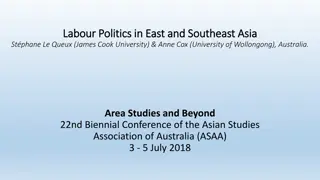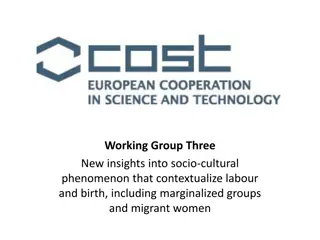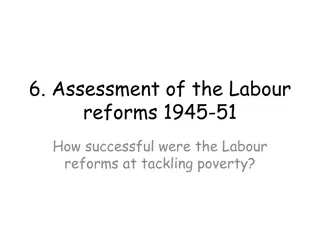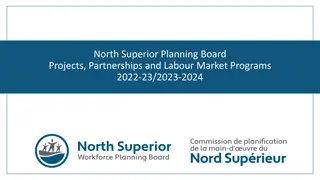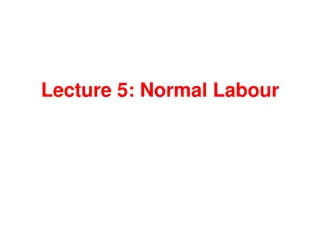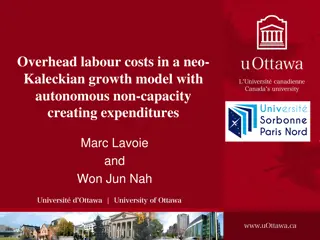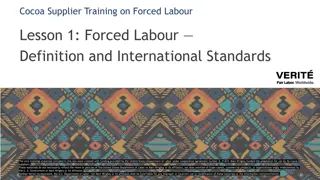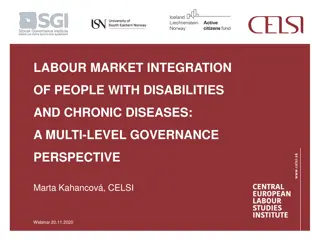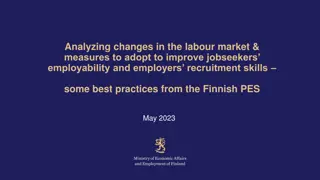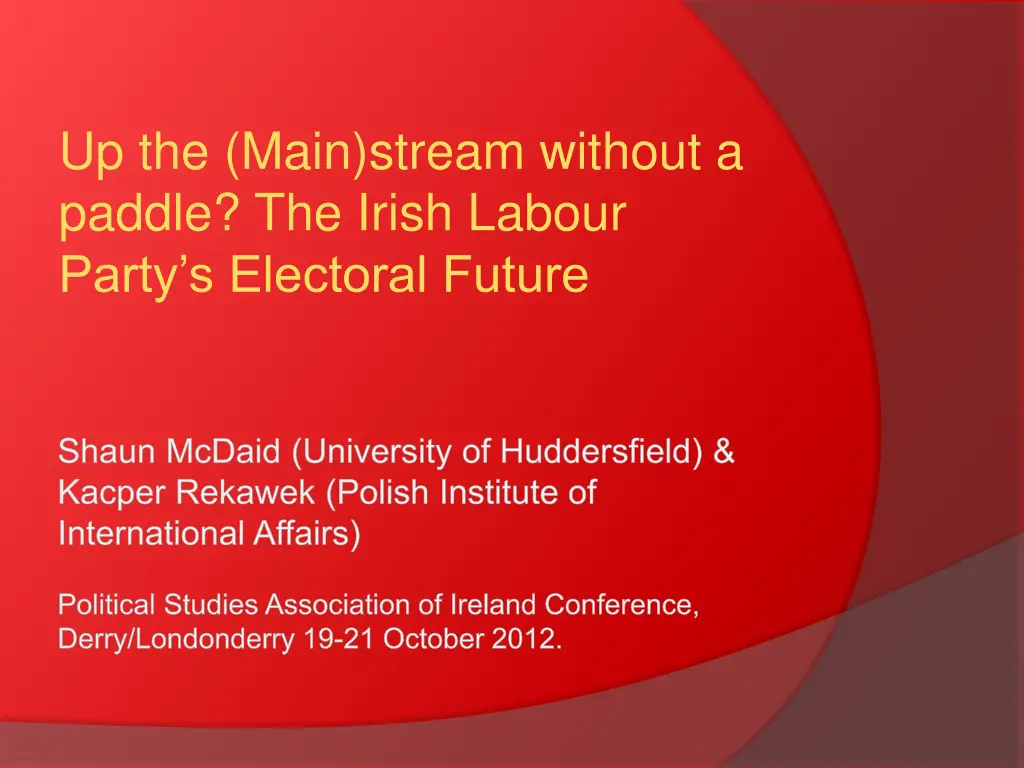
Labour Party's Electoral Future: Analyzing Irish Politics
Explore the Irish Labour Party's electoral journey, from historic breakthroughs to future prospects. Dive into past successes, challenges, and strategies for becoming a major player in Ireland's political landscape.
Download Presentation

Please find below an Image/Link to download the presentation.
The content on the website is provided AS IS for your information and personal use only. It may not be sold, licensed, or shared on other websites without obtaining consent from the author. If you encounter any issues during the download, it is possible that the publisher has removed the file from their server.
You are allowed to download the files provided on this website for personal or commercial use, subject to the condition that they are used lawfully. All files are the property of their respective owners.
The content on the website is provided AS IS for your information and personal use only. It may not be sold, licensed, or shared on other websites without obtaining consent from the author.
E N D
Presentation Transcript
Up the (Main)stream without a paddle? The Irish Labour Party s Electoral Future Shaun McDaid (University of Huddersfield) & Kacper Rekawek (Polish Institute of International Affairs) Political Studies Association of Ireland Conference, Derry/Londonderry 19-21 October 2012.
Futurology? We don t offer a philosophical or theoretical reflection on how Labour might develop We draw on opinion poll evidence and from examples of other periods in the party s history, particularly 1987-1992, which saw the party make comparable gains
Fig. 1 2011 versus 2007 results 45 40 35 30 2011 25 20 2007 15 10 5 0 Fine Gael Labour Fianna F il Sinn F in
Labour in 2011 Major breakthrough? An earthquake election ? (Gallagher and Marsh, 2011; Hutcheson, 2011). In 2011, Labour became the second largest party in the state for the first time Highest share of vote since 1922 Largest number of seats ever (37)
How did this happen? Public confidence in party leader, Eamon Gilmore Prevention and management of factionalism within the party More centralised organisation control over candidate selection, (see also Reidy, 2011), electoral literature etc. Party pledge . Domination of leftist rivals, e.g. Sinn F in
What kind of party is Labour? Major, minor, both or neither? Major party +15% of vote (Mair, 1987) O Malley (2010) <25% midpoint number of seats as the two largest parties Relevance coalition potential (Sartori, 1976) Does Labour require a new category?
A mainstream party? What is a mainstream party? Often close to major party; potential party of government; not ideologically constrained from coalition participation More influence than a mass party of left or right, if less numerical support Regularly poll more than its overall average in terms of %FPVs.
Labours average vote share 1923-2011 Figure 2. Changes in percentage of ILP vote 25 20 ILP votes in per cent of the total 15 10 5 ILP Vote at Different Elections Average ILP Vote 0 1923 1932 1933 1937 1938 1943 1944 1948 1951 1954 1957 1961 1965 1969 1973 1977 1981 1987 1989 1992 1997 2002 2007 2011 1927a 1927b 1982a 1982b General election
Labour: a proximal mainstream party? McDaid and Rekawek (2010; 2012) Coalition potential Occasional party of government Different from a relevant minor party, which need only be in government once Consistently poll, on average, 10 per cent or more Labour s overall average is 11.25%, 1923-2011
Did Labour break the mould in 2011? Has Labour now become a major player in the Irish party system? Will the 2011 election result in a re- alignment of the party system?
Second party strength in Ireland 80 70 60 50 % FPVs Seats 40 30 20 10 0 Nov. 1982 1992 2002 2011
Frankfurts way (and Alberts way) Previous episodes from the party s history are instructive During the 1987-92 period, Dick Spring made a name for the party by attacking Fianna F il Yet, in 1992, it decided to coalesce with it
Electoral backlash [W]e [ILP] didn t succeed at all We did the opposite of what people wanted us to do. People wanted us to deal with Fianna F il and get rid of them, put them in their place, and we join them! And when you join those people, the people who have given you that vote were aghast. (Interview with Joe Costello, TD)
Gilmores pre-election comments If the Taoiseach's Government knew Anglo-Irish Bank was insolvent and he asked the Irish taxpayer to bail it out and to pay the cost we are now paying for it, that was and is economic treason . It s Frankfurt s way or Labour s way.
Gilmores post election comments Those who make the call for not repaying [Anglo-Irish uninsured bondholders] have never spelled out what those consequences are . (Irish Times, 24 Jan. 2012) "It's a bit of a sickener to have to pay it, there is no doubt about that. (Breakingnews.ie, 25 Jan, 2012)
Party members views Fine Gael and Labour will be the two major parties going forward, certainly for the next five to ten years until things improve. (Interview with Ray Kavanagh, National Executive) Coalescing with Fine Gael reinforces the previous pattern and prevents the sought after left-right alignment. (Interview with Patrick Nulty, TD)
Effects Gilmore s popularity sliding 23% (Oct. 2012). Enda Kenny/Gerry Adams most popular leaders Poorer organisational coherence Shortall resignation, lack of support , etc. Internal divisions manifesting: Broughan, Nulty, Penrose, Shortall although still no formal group like Labour Left, Militant, etc. Loss of dominance of the Irish left Sinn F in now the leading voice
A pre-election backlash? (Red C Sunday Business Post poll data) 35 30 25 Fine Gael Fianna F il Sinn F in Labour 20 15 10 5 0 Sep June May
And the most recent poll Irish Times 17 October 2012 35 30 25 Fine Gael Fianna F il Sinn F in Labour 20 15 10 5 0 Fine Gael Fianna F il Sinn F in Labour
Stuck in the mainstream? Fine Gael appear safe as the largest party Fianna F il is holding up well (by some measures the 2ndparty) Sinn F in are the big winners so far Labour could be the biggest loser Evidence suggests a perpetuation of the cycle, and return to proximal mainstream status in the years ahead
Contact details Shaun McDaid, University of Huddersfield S.McDaid@hud.ac.uk Kacper Rekawek, Polish Institute of International Affairs rekawek@pism.pl

